Rhinoplasty is the hardest and most technically demanding procedure that a plastic surgeon encounters in his career. With secondary and tertiary revision rhinoplasty, the level of difficulty is even greater.
What rhinoplasty revision entails is scar tissue that can hinder the procedure from start to finish and a smaller amount of material to work with than usually. This means that there is a possibility of using cartilage tissue from your ears or ribs for the rhinoplasty revisions. The alternatives to not using your own tissues are implants such as silicone, medpor, cadaveric cartilage and polyethylene. These alternatives are more popular for people who do not wish to have cartilage taken from their ears or ribs.
Dr. Young remembers a nose revision rhinoplasty that he performed on a woman whose implant was protruding from the tip of her nose. She had the implant surgery in Korea and came to Dr. Young for help.
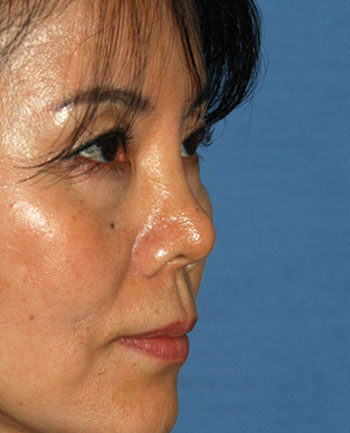
Before Asian Rhinoplasty Revision
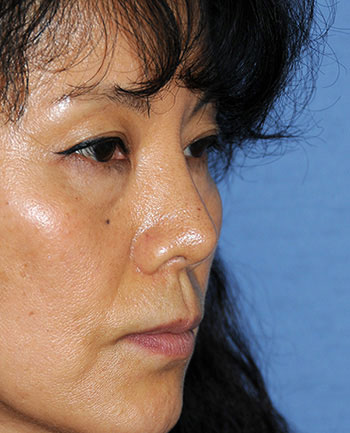
After Asian Rhinoplasty Revision
Note: Individual results will vary. Images do not constitute a promise or representation of any particular outcome or experience.
This case was extremely difficult because the implant had eroded through her skin and severely damaged her underlying cartilages. Inherently, Asian noses have weaker cartilages and structure. Dr. Young knew she would require a “reconstructive effort” or reconstructive rhinoplasty. The mission was to put her nose back together and build it up in the process. Among the options, there was the use of a rib graft by itself, a combination of ear cartilage/temple fascia (tissue covering the temporalis muscle), and medpor implant for the tip or medpor/silicone implants.
Given her problems with the silicone implant, using any other implants was not a great idea to solve her problem. Harvesting rib was also not a good option. Eventually, Dr. Young chose a combination of ear cartilage, temporalis fascia, and medpor sheets to present the natural tip cartilages. The plan was to take out the implant first and give the nose some time to rest. The purpose of this two-step process was to avoid infections by placing cartilage or another implant in the nose in the setting of the implant extrusion, which is considered an infection prone nose.
After waiting two weeks, we hoped to carry out the definitive revision by taking the ear cartilages and mince it into small pieces before placing them in a fascial blanket shaped into a nasal bridge. This natural implant was to be placed in the dorsum and more cartilage added on the sides of the tip and on the tip itself to increase the height.
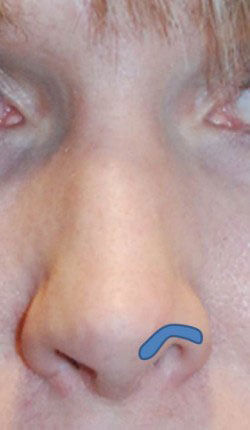
Before
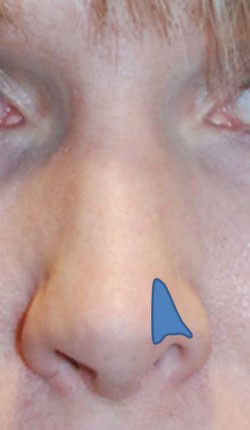
After
Note: Individual results will vary. Images do not constitute a promise or representation of any particular outcome or experience.
The scar on the tip of her nose will get better with time. A scar revision will be considered in the future to improve the tip area where the implant came out through the skin. The patient is extremely happy at this point in her recovery.
Dr. Young was also involved with a woman that had rhinoplasty before and was interested in a secondary revision rhinoplasty. She was not happy that her nostrils flared upwards and showed a “snarling” type of appearance. She also felt that her nostrils on the sides were too high and wanted to lower them. Most of the time, it entails using tissue from somewhere else to make the nostril rim come down. You can advance tissue, add some cartilage and skin from the ear to the inside and add cartilage along the rim of the nostril to pull it down.
In the two revision rhinoplasty procedure pictures above, the blue shape indicates where you would put a cartilage graft within the nostril hidden through an incision inside the nose. This cartilage graft can come from the septum or ear cartilage. When the retraction of the nostril rim is more severe, you can use composite grafts or grafts that have skin and cartilage. These composite grafts are usually taken from the ear in a well-hidden incision.
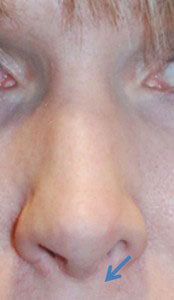
Dr. Young’s Circles of Prominence Theory
Note: Individual results will vary. Images do not constitute a promise or representation of any particular outcome or experience.
In the above example, the blue arrow shows the idea of advancing the nostril rim to lower the whole nose on the side to help the retraction more. This was caused by liberal resection of tissue on the side of the nostril often used to narrow the width of the nose in this area. The procedure to narrow the nose is often called a weir excision. The goal is to reverse the weir excision to a degree by advancing the nostril rim completely downward.
A third case of a rhinoplasty revision showed a patient that had some irregularities after a previous rhinoplasty had been done several years before. She wanted a rhinoplasty revision/secondary reconstruction. She did not like the “butt” in the area under the tip.


